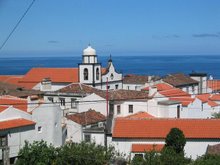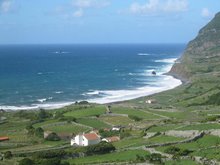Looking a bit like a Faroese fjord on whale hunt day, that's actually a tin of squid stuffed with a subtle blend (devised by Pitéu's award winning team of chefs) of onion, rice, tomato, spices and salt. It's floating in a liquid which looks as if it would be more at home in an automatic gearbox but which is described on the box as "American Sauce". And actually it's one of the tastiest things I've ever eaten - really. And I don't normally like squid (calamares) considering as I do stripped out silicone bathroom sealant to be more palatable.
Eat yer heart out Taste of Savoie!
Another fave lunch is sardines but not just any old sardines, they must be petingas. These are much smaller than common or garden sardines (you get about 7 or 8 to a tin instead of the usual 2-3) and have a much more subtle flavour - or they probably would if they didn't come drizzled in a medley of anti-fouling and WD-40 called tomate picante
Whether it's lulas or petingas, though, they should be accompanied by crusty fresh bread to mop up the sump oil delicate sauce. (Do you remember when cans of soup used to carry the warning "Do not boil to avoid impairing the delicate flavour"?) My bread of choice is the humble papo seco which means dry - er, I don't actually know what papo means (in my dictionary it says it means "chat" but that can't be right - Marisa?)
Anyway, such are their delicate sauce absorption properties, I suggest that, next time there's an oil spill, they simply scatter the area with papos secos - about half a dozen ought to cope with a spill of Exxon Valdez proportions.

Environmental disaster threatens as an offshore American Sauce well suffers a catastrophic blow-out
And then, if you've got any bread left over, you could always have a spread of Pé de Torresmo. This surprisingly more-ish blend of polyfilla and red diesel is manufactured by an outfit called Sociedade Industriale de Carnes Lda. which translates as "Industrial Meat Company" - I wonder which marketing genius came up with that. It probably doesn't do to dwell too much on the factory conditions.
Shortbread to go with our afternoon tea today, though!










4 comments:
Mmmm, love me some papo-secos, with either Azorean butter or any of a number of wonderful local cheeses!
Do you have cracas or lapas (limpets, I think, in English) on Flores? I'm pretty sure I saw a guy gathering one or the other of them at low tide in Santa Cruz one day.
well Neil papo does indeed means chat,but in brasilien, and in portuguese the word alone stands for something like stomach, or as a verb eu papo - i eat, or está no papo/já cá canta - it´s in the bag, as something realy easy to acomplish. and of course our papo-seco - a little bread.
The problem is that we have the so called "Acordo Ortográfico" something horrendus that wants to normalize? the language, wich menas that we all are going to write in brasilien. Not for me, anyway.
Marisa - thanks for comment. You are right to remind me that things I read in my dictionary may be Brazilian rather than Portuguese.
Kathie - we have lapas (yes, limpets in English) on Flores but I am surprised how small they are here. In Scotland they're massive great pyramids you could seriously stub your toe on. And we'd never dream of eating them. Mussels yes but limpets no. Funny the differences between countries' attitudes ...
1. "Papo-seco" literally means dry jaw, so I just logically assumed it referred to the fact that the rolls by themselves (without butter, cheese or other moist-ish accompaniment) would tend to make one's mouth dry out.
2. In terms of what one might otherwise never consider eating (heaven forfend!): I'm convinced that three factors combined over the centuries to create a characteristically Azorean style of Portuguese cuisine:
a) The poverty that so many Azoreans long suffered, which tended to encourage them to forage for free food wherever possible, e.g., fish and shellfish, small game (e.g., birds, rabbit), wild-growing produce like (on Flores) watercress (my family's watercress soup recipe is heavy on the cress, light on onions and potatoes, uses water instead of stock, plus stale bread);
b) The need not to waste a scrap of foods that people raised (such as "variety" meat cuts), and in the pre-refrigeration era marinating meats/seafood in order to preserve them (e.g., "vinha d'alhos" for pork, a variation on which is one of the few Portuguese recipes to have survived my family's single-minded cultural-assimilation campaign -- yeah, I sure showed them!); and,
c) The isolation of the islands, so that each needed to be as self-reliant WRT comestibles as possible (even now one can't always rely on inter-island transportation to bring in food on schedule during foul weather).
3. The latest set of proposed orthographic reforms (which I first learned of on Azorean TV whilst riding the pasenger ferry from Horta, Faial, to Velas, São Jorge, in May 2008) tend to streamline European Portuguese spellings to Brazilian standards, which are the most widely used in the Lusophone world (sort of a "majority rules" situation). E.g.:
óptimo/a => ótimo/a
acção => ação
Post a Comment